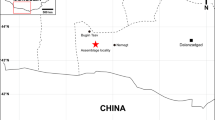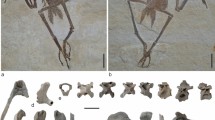Abstract
Characteristics of the postcranial skeleton of Arvernoceros ardei and Cervus perrieri from Perrier (France, late Pliocene, 2.78 ± 0.01 Ma BP, MNQ 16b) are described and distinguished. This was made possible by using the skeletal remains of A. ardei from Kaltensundheim (Germany, Thuringia, late Pliocene age) as identification keys. C. perrieri did not occur in Kaltensundheim. Twenty-five skeletal differences of A. ardei and C. perrieri are detected, and are compared to the genera Eucladoceros, Cervus, Praemegaceros and Megaloceros. The results demonstrate a high level of conformity of A. ardei with Eucladoceros in predominantly plesiomorphic features; major differences exist between A. ardei and Cervus, and A. ardei and Megaloceros. C. perrieri shows several similarities with Cervus elaphus, in which both differ from A. ardei and Eucladoceros. An association of C. perrieri to the genus Cervus is indicated by the postcranial skeleton, as has been discussed in the literature based on antler characteristics. By the findings of Kaltensundheim, a precise association of dental and skeletal characteristics to A. ardei is possible now. The allocation of E. giulii from Untermaßfeld (Germany, Thuringia, Jaramillo event) to the genus Arvernoceros appears doubtful based on the dental and skeletal features of A. ardei from Kaltensundheim and Perrier. The original classification within the genus Eucladoceros is considered probable.
























Similar content being viewed by others
References
Abbazzi, L., R. Croitor, and A. David. 1999. Megaceroides obscurus (Azzaroli, 1953) (Mammalia, Cervidae) from early Pleistocene sites of Eastern Moldova. Acta Zoologica Cracova 42(3): 377–392.
Azzaroli, A., and P. Mazza. 1992. Large Pleistocene deer from Pietrafitta lignite mine, Central Italy. Palaeontographia Italica 80: 1–24.
Bachofen-Echt, A. 1929. Die Stellung der Mosbacher Geweihe von Cervus elaphus in der Entwicklungs-Reihe dieses Hirsches. Notizblatt der Vereinigung für Erdkunde der Hessischen Geologischen Landesanstalt Darmstadt 5(12): 171–176.
Böhme, G. 1963. Über den Skelettfund eines Pliocerviden aus dem Pliozän von Kaltensundheim/Rhön. Paläontologische Abhandlungen 1(4): 297–405.
Bohlin, B. 1926. Die Familie Giraffidae mit besonderer Berücksichtigung der fossilen Formen aus China. Palaeontologia Sinica (Series C) 4(1): 1–178.
Bosold, K. 1968. Geschlechts- und Gattungsunterschiede an Metapodien und Phalangen mitteleuropäischer Wildwiederkäuer. Säugetierkundliche Mitteilungen 16: 93–153.
Bravard, A. 1828. Monographie de la Montagne de Paris, 1–145. Paris: Dufour.
Croitor, R., and D. Kostopoulos. 2004. On the systematic position of the large-sized deer from Apollonia, Early Pleistocene, Greece. Paläontologische Zeitschrift 78(1): 137–159.
Croitor, R. 2005. Large-sized Deer from the Early Pleistocene of south-east Europe. Acta Palaeontologica Romaniae 4: 97–104.
Croitor, R. 2009. Systematical position and evolution of the genus Arvernoceros (Cervidae, Mammalia) from Plio-Pleistocene of Eurasia. Muzeul Olteniei Craiova, Oltenia. Studii şi comunicări. Ştiinţele Naturii 25: 375–382.
Croitor, R. 2012. Lower Pleistocene ruminants from Monte Riccio (Tarquina, Italy), Oltenia. Studiile şi comunicări. Ştiinţele Naturi 25: 375–382.
Croizet, J.-B., and A. Jobert. 1828. Recherches sur les ossements fossiles du département du Puy-de-Dóme. ed. A. Delahays. 1–224. Paris and Clermont-Ferrand.
Crusafont-Pairó, M., and C.J.F. Villalta. 1951. Los nuevos mamíferos del Neógeno de España. Notas y Comunicaciones del Instituto Geológico y Minero de España 22: 1–25.
David, A. 1992. A new deer species (Cervidae mammalian) from the late Pleistocene deposits of Moldova. Buletinul Academiei de Ştiinţe din Republica Moldova. Seria Ştiinţelor Chimice şi Biologice. Chişinău 1: 67–68. (in Russian).
De Giuli, C. 1987. Late Villafranchian faunas of Italy: The Selvella-Local Fauna in the southern Chiana valley—Umbria. Paleontographica Italica 74: 11–50.
Depéret, C. 1884. Nouvelles études sur les Ruminants pliocènes et quaternaires d’Auvergne. Bulletin de la Société Géologique de France 3(12): 247–284.
Dietrich, W.O. 1938. Zur Kenntnis der oberpliozänen echten Hirsche. Zeitschrift der deutschen geologischen Gesellschaft 90 (5): 261–267.
Driesch, A. von den. 1976. Das Vermessen von Tierknochen aus vor- und frühgeschichtlichen Siedlungen. München: Institut für Paläoanatomie, Domestikationsforschung und Geschichte der Tiermedizin, LMU.
Dubois, E. 1904. On an equivalent of the Cromer Forest Bed in The Netherlands. Proceedings, Koninklijke Nederlandsche Akademie von Wetenschappen (Section Science) 7(3): 214–222.
Falconer, H. 1868. Notes on fossil species of Cervus, including a description of remarkable fossil antler of a large species of extinct Cervus on the collection of the Rev. John Gunn, Irstead. Falconer Palaeontological Memoires and Notes 2: 471–480.
Goldfuß, G.A. 1820. Handbuch der Zoologie 2(2): 374. Nürnberg: Johann Leonhard Schrag.
Grubb, P. 2000. Valid and invalid nomenclature of living and fossil deer, Cervidae. Acta theriologica 45(3): 289–307.
Guérin, C. 2007. Biozonation continentale du Plio-Pléistocène d’Europe et d’Asie occidentale par les mammifères: état de la question et incidence sur les limites Tertiaires/Quaternaire et Plio/Pléistocène. Quaternaire 18(1): 23–33.
Heintz, E. 1970. Les Cervidés villafranchians de France et d’Espagne. Mémoires du Muséum d`Hìstoire naturelle (n. s.) 22: 1–303.
Heintz, E., C. Guérin, R. Martin, and F. Prat. 1974. Principaux gisements villafranchiens de France: listes fauniques et biostratigraphie. Mémoires B.R.G.M. 78: 411–417. (Ve congrès Néogène méditerranéen-Lyon, 1971).
Janis, C.M., and A.M. Lister. 1985. The morphology of the lower fourth premolar as taxonomic character Ruminantia (Mammalia; Artiodactyla), and the systematic position of Triceromeryx. Journal of Paleontology 59(2): 405–410.
Kahlke, H.-D. 1965. Die Cerviden-Reste aus den Tonen von Voigtstedt in Thüringen. Paläontologische Abhandlungen (A: Paläozoologie) 2(2/3): 379–424.
Kahlke, H.-D. 1969. Die Cerviden-Reste aus den Kiesen von Süßenborn bei Weimar. Paläontologische Abhandlungen (A: Paläozoologie) 3(3/4): 547–610.
Kahlke, H.-D. 1997. Die Cerviden-Reste aus dem Unterpleistozän von Untermaßfeld. In Das Pleistozän von Untermaßfeld bei Meiningen (Thüringen). Teil1., ed. R.-D. Kahlke. Monographien des Römisch-Germanischen Zentralmuseums Mainz 40(1): 181–275.
Kahlke, H.-D. 2001. Neufunde von Cervidenresten aus dem Unterpleistozän von Untermaßfeld. In Das Pleistozän von Untermaßfeld bei Meiningen (Thüringen). Teil 2., ed. R.-D. Kahlke. Monographien des Römisch-Germanisches Zentralmuseums Mainz 40(2): 461–482.
Kostopoulos, D.S. 1997. The Plio-Pleistocene artiodactyls (Vertebrata, Mammalia) of Macedonia, 1. The fossiliferous site “Apollonia-1”, Mygdonia Basin of Greece. Geodiversitas 19(4): 845–875.
Lister, A.M. 1987. Diversity and evolution of antler form in Quaternary deer. In Biology and Management of the Cervidae, ed. C.M. Wemmer, 81–98. Washington, D.C.: Smithsonian Institution Press.
Lister, A.M. 1996. The morphological distinction between bones and teeth of Fallow Deer (Dama dama) and Red Deer (Cervus elaphus). International Journal of Osteoarchaeology 6: 119–143.
Made, J. van der, and V. Dimitrijevc. 2015. Cervidae from the lower Pleistocene of Trlica (Montenegro). Quaternary International 389: 90–118.
Made, J. van der, and H.W. Tong. 2008. Phylogeny of the giant deer with palmate brow tines Megaloceros from west and Sinomegaceros from east Eurasia. Quaternary International 179: 135–162.
Mai, D., and H. Walther. 1988. Die pliozänen Floren von Thüringen, Deutsche Demokratische Republik. Quartärpaläontologie 7: 55–297.
Mein, P. 1989. Updating of MN zones. In European Neogene Mammal Chronology, eds. E.H. Lindsay, V. Fahlbusch, and P. Mein, 73–90. New York: Plenum.
Nesti, F. 1841. Report of the meeting of Sept. 25th, summarized by P. Savi and A. Sismonda. Atti della Terza Riunione degli scienziati Italiana tenuta in Firenze nel 1984: 159.
Nomade, S., J.-F. Pastre, H. Guillou, M. Faure, C. Guérin, E. Delson, E. Debard, P. Voinchet, and E. Messager. 2014. 40AR/39AR constraints on some French landmark Late Pliocene to Early Pleistocene large mammalian paleofaunas: Paleoenvironmental and paleoecological implications. Quaternary Geochronology 21: 2–15.
Palombo, R., and A.M.F. Valli. 2004. Remarks on the biochronology of Mammalian Faunal complexes from the Pliocene to the Middle Pleistocene in France. Geologica Romana 37: 145–163.
Petronio, C., and L. Pandolfi. 2011. The genus Arvernoceros Heintz, 1970 in Italy: Preliminary report. Il Quaternario 24: 164–166.
Pfeiffer, T. 1997. Dama (Pseudodama) reichenaui (Kahlke, 1996) aus den Mosbach-Sanden (Wiesbaden-Biebrich). Mainzer Naturwissenschaftliches Archiv 35: 31–59.
Pfeiffer, T. 1998a. Capreolus suessenbornensis Kahlke, 1960 aus den Mosbach Sanden (Wiesbaden-Biebrich). Mainzer Naturwissenschaftliches Archiv 36: 49–76.
Pfeiffer, T. 1998b. Die fossilen Damhirsche von Neumark-Nord (Sachsen-Anhalt)—Dama dama geiselana n. ssp. Eiszeitalter und Gegenwart 48: 72–86.
Pfeiffer, T. 1999a. Die Stellung von Dama (Cervidae, Mammalia) im System plesiometacarpaler Hirsche des Pleistozäns—Phylogenetische Rekonstruktion—Metrische Analyse. Courier Forschungsinstitut Senckenberg 211: 1–218.
Pfeiffer, T. 1999b. Sexualdimorphismus, Ontogenie und innerartliche Variabilität der pleistozänen Cervidenpopulationen von Dama dama geiselana Pfeiffer, 1998 und Cervus elaphus L. (Cervidae, Mammalia) von Neumark-Nord (Sachsen-Anhalt, Deutschland). Berliner Geowissenschaftliche Abhandlungen (E: Paläobiologie) 30: 207–313.
Pfeiffer, T. 1999c. The Morphological Distinction of Limb Bones of Alces latifrons (Johnson, 1874) and Megaloceros giganteus (Blumenbach, 1799). Kaupia. Darmstädter Beiträge zur Naturgeschichte 9: 113–126.
Pfeiffer, T. 2002. The first complete skeleton of Megaloceros verticornis (Dawkins, 1868) Cervidae, Mammalia, from Bilshausen (Lower Saxony, Germany): description and phylogenetic implications. Mitteilungen aus dem Museum für Naturkunde Berlin (Geowissenschaftliche Reihe) 5: 289–308.
Pfeiffer, T. 2005. The position of Dama (Cervidae, Mammalia) in the system of fossil and living deer from Europe – Phylogenetical analysis based on the postcranial skeleton. In Les Ongulés Holarctiques du Pliocène, ed. E. Crégut-Bonnoure. Quaternaire, Hors–série 2-2005: 39–57.
Pfeiffer-Deml, T. 2016. Deer from the Pliocene site of Bad Deutsch-Altenburg 26 (Lower Austria, Leithagebirge)—Conclusions based on skeletal morphology. Annalen des Naturhistorischen Museums Wien 118: 133–173.
Portis, A. 1920. Elenco delle specie di Cervicorni fossili in Roma e attorno a Roma. Bolletino della Societa Geologica Italiana 39: 132–139.
Radulesco, C., and P.-M. Samson. 1985. Pliocene and Pleistocene mammalian biostratigraphy in South-Eastern Transylavania (Romaniia). Travaux de l’Institut de Spéologie “Emile Racovitza” 24: 85–95.
Schaarschmidt, E. 1958. Fund eines Mastodon in der Rhön. Neue Museumskunde 1: 290–292.
Spaan, A. 1992. A revision of the deer from Tegelen (province of Limburg, The Netherlands). Scripta Geologica 98: 1–85.
Vislobokova, I., M. Sotnikova, and M. Erbaeva. 1995. The Villafranchian mammalian fauna of the Asiatic part of fomer USSR. Il Quaternario 8(2): 367–376.
Vislobokova, I.A. 1979. A new deer from the pliocene of mongolia. Transactions of the Joint Soviet-Mongolian Paleontological Expedition 8: 31–38.
Vislobokova, I.A. 2013. Morphology, Taxonomy, and Phylogeny of Megacerines (Megacerini, Cervidae, Artiodactyla). Paleontological Journal 47(8): 833–950.
Vislobokova, I.A., and C. Hu. 1990. On the evolution of megacerines. Vertebrata Palasiatica 28: 150–158.
Acknowledgements
I wish to thank Prof. Dr. H.-D. Kahlke† and Prof. Dr. R.-D. Kahlke (IQW Weimar) for permission to study the deer material from Kaltensundheim a few years ago. Their kind support during my visits to Weimar was of great help for this study. I wish to thank Prof. (em.) Dr. Wighart v. Koenigswald, and Prof. (em.) Dr. Günther Deml for helpful discussions and comments. I am very grateful to various scientists and curators who allowed me to study material in their care: Dr. Christine Argot, Prof. Dr. P. Tassy (MNHN, Paris), Mrs. R. Lücht (IHK, Kiel), Dr. R. Hutterer (ZFMK, Bonn), Dr. O. Hampe, Dr. W.- D. Heinrich (MNHB, Berlin), Dr. G. Storch † and Dr. G. Plodowski (SMF, Frankfurt), Dr. G. Gruber (HLMD, Darmstadt), Dr. R. Ziegler and Dr. E. Heizmann (SMNS, Stuttgart), Dr. O. Neuffer, Dr. H. Jung (MNHM, Mainz), Prof. Dr. B. Engesser (NHMB, Basel), Prof. E. Tchernov † and Dr. R. Rabinovich (Hebrew University Jerusalem), Dr. J. de Vos and Prof. Dr. T. v. Kolfschoten (RMNH, Leiden), Prof. Dr. A. Azzaroli †, Prof. Dr. D. Torre, Dr. L. Abbazzi, Dr. L. Rook, Dr. M. Ferretti (IGF, Florence), Prof. Dr. C. Petronio, Dr. L. Capasso Babato, Dr. G. di Stefano (“La Sapienza”, Rome), Prof. Dr. C. Guérin, Dr. M. Faure, Dr. A. Valli (FSL, Lyon). Dr. Günther Deml kindly provided literature for this study and improved the photographs. I wish to thank Samantha Moody for correcting the English text. The investigation of the bone material from Kaltensundheim, Senèze, and the Upper Valdarno a few years ago was made possible by the financial support from the Deutsche Forschungsgemeinschaft (DFG). The useful text corrections and constructive review comments of Sabrina Curran and Jan van der Made have helped to improve this manuscript.
Author information
Authors and Affiliations
Additional information
Handling Editor: Irina Ruf.
Rights and permissions
About this article
Cite this article
Pfeiffer-Deml, T. Distinction of Arvernoceros ardei and Cervus perrieri (Cervidae, Mammalia) from the late Pliocene site of Perrier (France) based on the postcranial skeleton: taxonomic and phylogenetic conclusions. PalZ 94, 377–408 (2020). https://doi.org/10.1007/s12542-019-00473-y
Received:
Accepted:
Published:
Issue Date:
DOI: https://doi.org/10.1007/s12542-019-00473-y




